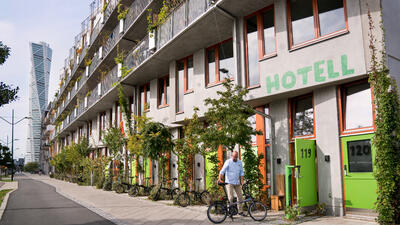“Trade, Conflict and Migration” Addressing the Displacement Crisis through Market-driven Trade Opportunities
Stockholm, 2 May 2016
Distinguished State Secretary,
Ladies and Gentlemen,
Thank you for inviting me to address you on trade, conflict and migration.
One would wonder what role an organisation like the International Trade Centre (ITC) which is a development agency of the United Nations and the World Trade Organisation, has to play in this area. ITC supports trade led growth, development and job creation. We focus on inclusive and sustainable development helping micro, small and medium sized enterprises (SMEs) in developing countries connect to markets, with a particular emphasis on women and youth. The ‘refugee and migrant crisis’ has a multitude of causes and hence any solution has to be multi-pronged. ITC addresses the need to provide opportunities for meaningful livelihoods both in the receiving country and the country of origin. This is nothing new, since it has been ITC’s core function for the last 50 years. What is new is the urgency to focus attention and efforts in building economic resilience. What is also pressing is the need for international and non-governmental organisations to better join efforts to achieve meaningful impact.
Last month, the International Organisation for Migration (IOM) released new record-breaking migration figures. The number of people residing outside of their country of origin grew to a staggering 244 million.
Next month, UNHCR will be publishing the latest statistics on the forcibly displaced. It is expected that the official number of refugees, internally displaced people and asylum seekers will exceed the entire population of Italy.
The international community is rising up to the challenge. The humanitarian response clearly comes first. We need to prevent conflict. We need to focus on saving lives in immediate danger and providing affected populations with the relief they need.
This is indisputable. As an international community we have a responsibility to do this.
Once situations become more protracted, the traditional humanitarian toolkit however, starts showing many limitations. After the initial crisis phase, livelihoods, societies, and economies need to be pieced back together. As the global migratory situation continues to worsen, we need to find new ways to tackle the problem – from all angles.
Let’s start with refugees. As State Secretary Oscar Stenström mentioned in his opening remarks, the average time a person lives in a refugee camp is 17 years. In Dadaab, for example, the ITC has interacted with third-generation refugees. That is, with the grandchildren of the Somalis that fled their country in the early 90s.
Just like any other human being, Dadaab residents aspire to make their own living, in dignity. But, after decades living in a camp, without the right to work too many questions remain unanswered: what can refugees now do to make an income? How can refugee livelihoods be organized in a way that is both legal and sustainable? And then also, what skills do they need for successful repatriation in the medium term.
This outlook repeats itself across the world. As displacement situations get more and more protracted, refugees may spend decades without work. We are creating generations of people who are not aware of what it means to work for a living. Though many refugees have access to training while in exile, education is not always linked to livelihood sources – to real income. Their skillsets deteriorate, or in a growing number of cases become obsolete. The popular misconception is that all refugees or indeed many migrants are people without skills and absent of contribution. This is far from the truth. Many of these people were living normal daily lives like you and I before a crisis struck.
They had skills- important skills that can be put to good use. They had aspirations. They have a contribution to make.
Thousands of refugee tailors and hairdressers have been trained, but then who hires them? How do they eke out a living?
With questions like these in mind ITC and the Office of the UN High Commissioner for Refugees decided to work together to address this gap. We wanted to bridge this traditional “humanitarian versus development” divide. The problem cannot be compartmentalized and most certainly not the solution. We joined our strengths to address forced displacement also from the trade and building productivity angle.
Over its more than 50 years ITC has developed strong competences in inclusive growth – ranging from empowering and employing women and youth, to boosting SME competitiveness and enabling poor communities to trade. We have seen first-hand how trade can help transform lives.
Our collaboration with UNHCR is about developing and implementing approaches for sustainable livelihoods in displacement settings. We are currently undergoing a similar exercise with the International Organization for Migration to assist the increasing populations of irregular migrants.
We are contributing to addressing the migratory crisis in three main ways.
First, addressing the socio-economic root causes of economic migrants; especially the lack of economic opportunities for young populations, the political situation permitting, of course. Many irregular migrants leave their place of origin because they cannot make a decent living at home.
ITC’s response is to roll out targeted interventions leading to enhanced SME competitiveness, entrepreneurial and self-employment opportunities leading to better and more stable jobs. Such initiatives offer livelihood opportunities while contributing to inclusive growth, sustainability and resilience.
In the Gambia, for example, ITC has teamed up with the IOM to address the challenge of young unemployed, potential migrants and returnees in high pressure areas, such as the North Bank and Upper River.
Together, we seek to build government capacity on issues relevant to migration and development, including migrant protection. It also responds to the immediate and medium-term needs of potential and return migrants, by boosting local development and providing alternatives through market-driven community projects. This project also reaches out to the country’s diaspora to support job creation through new export links.
Similar approaches are being developed in post-conflict countries, such as our Mano River initiative covering Guinea, Liberia and Sierra Leone. The focus here is on jobs and reconstruction, as the region was also ravaged by the Ebola epidemic.
I sometimes hear that it is an illusion to think that socio-economic development will stop migration to richer countries. Mobility is inherent to the human-being, so we will never be able to put up fences to human mobility. But we can and must address the causes that lead millions to risk their lives and that of their children in search for livelihoods.
A second approach focuses on building host country economic resilience, while empowering refugees to contribute actively to the sectors being supported. Here, ITC assists local SMEs in gaining competitiveness and providing employment opportunities in sectors where both locals and refugees can also contribute. Support spans across the entire value chain.
In Lebanon and Turkey, ITC has identified the potential of the home décor, furniture and carpet sectors, not only to underpin the country’s economic prosperity, but also to provide employment to locals and immigrants alike. In fact, Syrian artisans bring along unique wood handling and weaving skills which the Lebanese and Turkish SMEs can capitalize on as a complement to the skillset of their own workers.
In both cases, the SMEs get competitiveness boosting support in critical aspects. They learn to adapt their products to evolving client preferences. They are coached on techniques both to minimize environmental impact and make optimal use of raw materials. In addition, participating SMEs benefit from market prospecting, including the hosting of inward buyer missions. In short, these projects are to mentor local companies through the whole exporting process, from production techniques to use of e-commerce platforms.
As a result, employment in the whole sector receives a boost, which benefits locals and refugees. And the local economy gains resilience as SMEs contribute to increased employment, wealth generation and market diversification.
The third venue builds on ITC’s programmes on economic inclusion through trade for women, youth and poor people.
Our Ethical Fashion Initiative, for example, harnesses the productive potential of the urban poor, mostly women, with the help of social enterprises which also act as marketing links. Last week for example, Camper, a shoemaker from my own country, Spain, launched its collection of vegetable-tanned leather boots made in Ethiopia. Camper joins well-established brands such as Vivienne Westwood, Stella McCartney or United Arrows of Japan in providing an outlet to the creativity of artisans ranging from Accra and Nairobi to Ramallah and Port-au-Prince. Production follows fair trade standards and is carbon neutral. The results, as our monitoring tools show, are increased income and self-esteem which allow the beneficiaries, mostly women, to lift themselves out of poverty.
More generally, the approach is about providing market-driven income opportunities to different groups of vulnerable people, such as returning migrants, refugees and internally displaced people. Exporting social enterprises source from the beneficiaries, organized in micro-enterprises. The exporter provides them with technical support on production and handles the marketing relationships.
In Dadaab, for example we have confirmed the potential for internet-enabled livelihoods. Together with the Norwegian Refugee Council, we are implementing a pilot project to harness market-based incentives to upgrade skillsets and generate incomes. We involve Nairobi-based firms, already exporting Business Process Outsourcing services such as data entry work and document formatting. Skills development is geared to address actual needs from real clients.
The evidence so far shows high potential for sustainable income generation and also for commercial skills build-up. The grandchildren of Somali goat herders fleeing violence at home can have a shot at thriving in the digital economy. Our next step is to scale up this arrangement in a way that reaches out to larger numbers of people, both refugees and Kenyan nationals. We are also working with UNHCR and their partner Caritas in deploying this approach for the benefit of Syrian refugees living in Egypt.
These three market-led approaches are showing promise in addressing both refugee and migratory situations. We are still learning from the experience of others, while fine-tuning our own methodologies and rolling them out in different country settings.
ITC has so far focused on protracted displacement situations or in areas with high potential for irregular migration. Livelihoods work does require relative economic stability, together with strong government buy-in. From these early experiences, we are starting to note patterns, in terms of good practices, as they relate to the ITC.
First, we can’t do it alone. For our interventions to make sense, we need to align ourselves with the UNHCR’s livelihoods guidelines or with the International Organization for Migration’s strategy at the local level. For Palestine refugees, we are also reaching out to UNRWA for their guidance and operational collaboration.
We also require working with locally-based partners who are competent in working within complex settings. For this reason, we are joining forces with the Norwegian Refugee Council, with the Refugee Education Trust and other UNHCR partner organizations. For example, we work with graduates from our partners training courses (such as sewing or IT skills). We also use their existing facilities. Partners typically handle crucial aspects at the local level, such as community consultations, group dynamics, security and logistics. And these interventions need multi-funder support.
A second finding is that our starting point has to be where market demand and beneficiaries’ productive potential are likely to intersect.
For example, careful skill audits in the Mentao Camp in Burkina allowed us to focus on the traditional leather tanning and cutting skills of the Malian refugees. We also confirmed that a market exists for such products.
Actual project activities however start only upon confirmation through a detailed market study and a full supply gap assessment. In Dadaab, for example this also meant checking internet connectivity, electricity supply issues, and equipment safety, in addition to peoples’ computer skills. On the marketing side, our goal is to go beyond niche markets such as ‘fair trade’ outlets; instead we seek scalability by targeting commercial buyers who value impact sourcing. This market orientation provides the basis for sustainable impact, but requires strong discipline to satisfy evolving client demands.
The presence of refugees often entails a high cost to their host countries. It is therefore not only fair, but also politically imperative, for host countries to derive benefits from such technical assistance interventions. Our Dadaab project, for example, is explicitly designed to include Kenyan nationals as direct beneficiaries.
In addition, tax-paying SMEs receive key support, bringing about increased employment in higher value-added activities. These companies ensure critical links of the productive chain, such as product design, marketing, quality assurance or logistics.
Incidentally, this host country-centered approach typically helps build government goodwill when it comes to relaxing legal constraints on the work by the refugees themselves.
Three, we need to ensure that development aid is adequately channelled to building economic resilience. As we need to ensure good collaboration between development actors to ensure value for money. This aid, together with the power of the private sector will be crucial to address the growing needs.
In concluding, let me underscore that trade is an important elements in addressing the root causes of economic migration, particularly for the young. People with income are less likely to leave their homes to embark on a dangerous trek to a faraway land.
More vibrant SMEs will create jobs for locals and guests alike. They will also help build resilience for countries at the midst of the migratory turmoil.
Tapping market opportunities can contribute to unleash the potential of human beings who are deprived from their dignity. I have seen trade transform lives, from poor basket weaving women in Papua New Guinea to a 65 year old Maasai lady who still looks after the families of her six children.
At ITC we are actively looking for opportunities to make those trade links happen for the millions that have to leave their homes, while helping build resilience for the countries around these humanitarian hotspots. The effort is more than just worth it.
I thank you for your attention.











